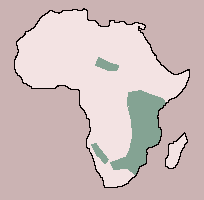Black Rhinoceros

| Class: Mammalia:
Mammals |
Diet: Leaves, buds,
shoots |
| Order:
Perissodactyla: Odd-toed Ungulates |
| Size: body:3
- 3.6 m (9 3/4 - 11 3/4 ft),tail: 60 - 70 cm (23 1/2 - 27 1/2 in) |
| Family: Rhinocerotidae:
Rhinoceroses |
Conservation Status: Critically endangered
|
| Scientific Name:
Diceros bicornis |
Habitat: bush country,
grassland, woodland |
| Range:
Africa: Southern Chad and Sudan to South Africa |
 The
black rhinoceros is, in fact, gray in color but varies according to the
mud in which it wallows. It has no hump on its neck but has a large head,
held horizontally, which bears two horns and sometimes a third small horn.
Its upper lip is pointed and mobile, which helps the animal to browse on
the leaves, buds, and shoots of small trees and bushes. Less sociable than
the square-lipped rhinoceros, black rhinoceroses live alone, except for
mothers and young. Adults live in overlapping home ranges, with boundaries
marked by dung heaps. Male and female remain together for only a few days
when mating. The female gives birth to a single young after a gestation
of about 15 months. The young rhinoceros suckles for about a year and stays
with its mother for 2 or 3 years, until her next calf is born. The
black rhinoceros is, in fact, gray in color but varies according to the
mud in which it wallows. It has no hump on its neck but has a large head,
held horizontally, which bears two horns and sometimes a third small horn.
Its upper lip is pointed and mobile, which helps the animal to browse on
the leaves, buds, and shoots of small trees and bushes. Less sociable than
the square-lipped rhinoceros, black rhinoceroses live alone, except for
mothers and young. Adults live in overlapping home ranges, with boundaries
marked by dung heaps. Male and female remain together for only a few days
when mating. The female gives birth to a single young after a gestation
of about 15 months. The young rhinoceros suckles for about a year and stays
with its mother for 2 or 3 years, until her next calf is born.

  
|
